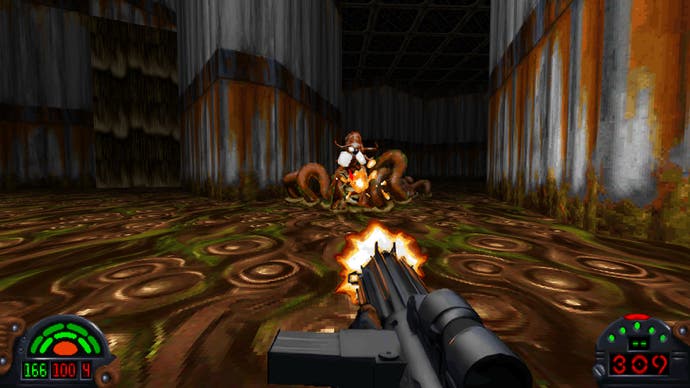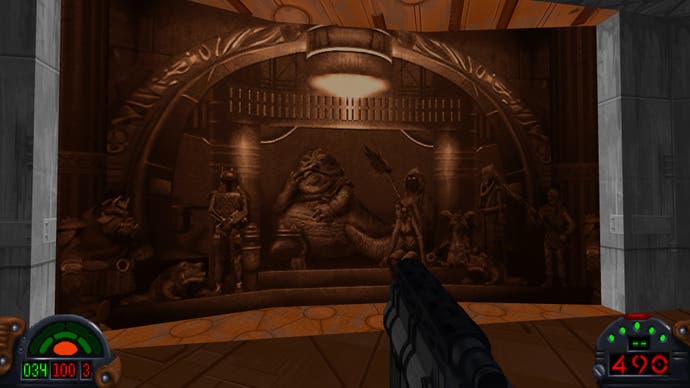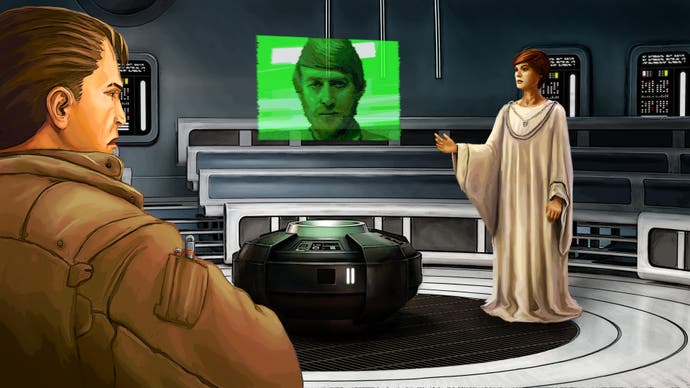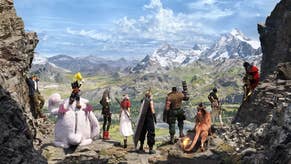Star Wars: Dark Forces Remaster review - a meticulous overhaul of a shooter that still blasts with the best
Return of the deadeye.
Dark Forces emerges from Nightdive's bacta tank refreshed and ready for action, combining classic FPS mayhem with thrilling espionage-themed missions.
"This is too easy" quips Kyle Katarn as he snatches the Death Star plans in Dark Forces' opening mission. What took Rogue One two-and-a-half ponderous hours to unspool, LucasArts' shooter pulls off in ten thrilling minutes. For Katarn, a cocky mercenary in tentative accord with the Rebel Alliance, stealing the Death Star plans is just another contract. In, out, job done.
Katarn's confidence and competence is echoed both in Dark Forces at large and Nightdive's work restoring it. The remaster is a consummately professional overhaul, making the game look just how you remember it in a way that belies the work involved to get it to this stage. In doing so, Nightdive reveals a shooter that hits the brief like a proton torpedo, a Doom clone elevated by its vivid, imaginative expansion upon the Star Wars universe.
To make Dark Forces play effortlessly on modern machines, Nightdive has had to dig deep. The studio has rebuilt the game from its original foundations, taking Dark Forces' source code and reconstructing the game in the studio's in-house Kex-engine. Moreover, the game's art has been completely redrawn to look crisp on modern, high-res displays.
The result is a game that looks sharp and fresh, but crucially, not new. Emerging from the introductory vent into Secret Base felt like playing a whole new version of Dark Forces, and more like falling through a wormhole back to my first PC in 1997. The rumbling MIDI soundtrack, the modulated "Hey, who goes there?" from Stormtroopers, the way officers' hats fly off as you blast them to the ground - it all felt indistinguishable from my first encounter with LucasArts' shooter. That is, until I hit F2 and switched to software rendering mode, which narrows the screen to 4:3 and displays the game in its original, watery glory.
Venturing deeper, a few presentational blemishes appear. Occasionally, corpse sprites will be overlapped by the world geometry when viewed at certain angles, causing some unsightly glitches. Moreover, while the redrawn 2D in-game objects look fantastic at higher resolutions, the same cannot be said for the game's handful of 3D objects, such as the laser turrets. In the original, software rendered version of the game, these objects blend neatly into the broader art design. In stark, hardware accelerated HD, their blocky simplicity really stands out like an untextured thumb.
Broadly though, this is an excellent restoration. Particular praise should be given to the reconstructed cutscenes, which are an essential part of Dark Forces. The redrawn 2D sprites are wonderfully characterful (especially Kyle Katarn's Chandlerian scowl) while the rebuilt 3D sequences are genuinely spectacular. The dramatic scenes of the Moldy Crow swooping through space, or the Dark Troopers being deployed fatefully onto Talay, verify the game's Star Wars credentials.
Indeed, the quality of these cutscenes are vital to Dark Forces, because what defines LucasArts' shooter now, as it did then, is context. Dark Forces takes the abstract gunplay of Doom and lends it both narrative and environmental specificity. Following Katarn's retrieval of the Death Star plans, he's sent on the trail of a new weapon the Empire is engineering – the Dark Trooper.
There's less mystery to the story than I remember – you know roughly what the Dark Trooper is by the end of mission two. Instead, the story is all about giving each mission a clear and exciting shape, much like LucasArts did with X-Wing and particularly TIE Fighter in previous years. After stealing the Death Star plans, Kyle is sent to Talay Tak Base to investigate the site of a recent Imperial attack. What he finds are blaster-scorched Rebel buildings infested with Stormtroopers, and charred, twisted corpses of the Rebels stationed there, hinting at the Dark Trooper's power.



In this way, each mission has its own distinctive flavour, bringing something different to the experience. Gromas Mines sees you dodging through industrial drills on a rust-coloured planet for a showdown with the Phase 1 Dark Trooper, while Ramsees Hed makes up for it with some knotty, transforming level design. The best missions are the ones that make you feel most like a Rebel agent, like scouring the crags of Planet Fest for the secret entrance to the Imperial base there, or trekking across the ice of the Robotics Facility to sabotage the Dark Trooper Assembly Line.
My favourite mission in the game is Detention Centre, where you're sent to spring an Imperial informant from a high-security prison. It's Dark Forces' equivalent of the first film's Death Star escape, only here you're breaking in rather than out. The complex is riddled with Star Wars fan service, from the hexagonal detention block corridors, to how you access them through a garbage compactor complete with Dianoga monsters lurking in the slurry. But it's also a satisfying space to unpick. Blasting stormtroopers as you frantically input imperial codes into computers evokes Luke and Han's chaotic attempt to free Leia from Vader's clutches, while accessing the right detention block involves more ingenious methods of bypassing security.


These evocative scenarios were what made Dark Forces so exciting in 1995, and they largely hold up today, even with far more lavish Star Wars experiences around. The game's lack of lightsabers and Force powers gives it some lasting distinction, but it's also just a tightly designed shooter. The 3D levels are mazey and complex, yet small enough that you can mostly feel your way around them (Anoat City being the major exception). The combat remains surprisingly tactile too, with fantastic sound effects, reactive enemies, and a great array of weapons. The E-11 blaster deserves a place alongside Doom's shotgun in the video game weapon hall of fame, while more powerful weapons like the Mortar Launcher and Concussion Rifle require some skill to wield without disintegrating yourself. The Arc Cannon is also a fantastic late-game weapon. Doubling as a rapid fire plasma rifle and a rocket launcher, it lets you rip through the game's last few levels, and go toe-to-toe with those hulking Dark Troopers in explosive duels.
Dark Forces even holds up in areas where I thought it certain to feel archaic, such as how it mediates player progression. Dark Forces doesn't let you save during missions. Instead, your progress is maintained through lives. You get three by default on medium difficulty, with extra lives hidden throughout the levels. Dying respawns you a few steps back from the point of your demise, until you run out of lives, at which point you'll have to restart.
Hot off the back of Wrath: Aeon of Ruin, a game with its own idiosyncratic save system, I wasn't especially up for this. But the lives system proves to be both liberating and unobtrusive. Three lives are more than sufficient to navigate most levels on medium difficulty, and the promise of extra lives makes secret hunting that much more rewarding.
That said, Dark Forces does have a few flaws. The game isn't especially strong when it comes to ending levels. The best endings are those that see you picked up by your copilot Jan Ors in the Moldy Crow, lending a neat circuitry to your mercenary escapades. But missions where you need to track down a character just tend to end when you find them, which is always a bit unsatisfying. Doom at least has you throw a switch before the level bleeds away to the completion screen.
Yet the game's biggest flaw is its fascination with exploding mines. Mines are both a weapon and a hazard in Dark Forces. They suck in both functions. But in the latter they're a downright menace. They trigger quickly and have a huge splash radius, which makes them difficult to avoid. The second half of the game frequently ambushes you with them, placing them around corners and underneath item pickups. One mission, Jabba's Ship, is absolutely littered with mines. In a level that starts with you fighting a giant lizard with only your fists, it's the mines that make it a miserable experience.
Nonetheless, I'm pleasantly surprised by how much I enjoyed returning to Dark Forces. I've long hoped LucasArts' first FPS would one day receive a remake, as I thought the original was just a bit too creaky to fly in the modern age. Now I've played this remaster, I'm no longer sure it needs one. Nightdive's makeover reveals an exciting, smartly designed shooter that superbly encapsulates Star Wars' more roguish side. Few Star Wars games can escape the gravitational pull of the Jedi, but Dark Forces remains one of the best examples that does.
This project also poses exciting questions for the road ahead, as Nightdive's deal with Disney to overhaul Dark Forces leaves open the possibility for a remaster of Jedi Knight. Dark Forces' sequel is not just a great Star Wars FPS, but one of the best 3D shooters of the nineties, with a truly colossal sense of scale and some incredibly advanced ideas for its time. But always in motion is the future. For now? Job done.












